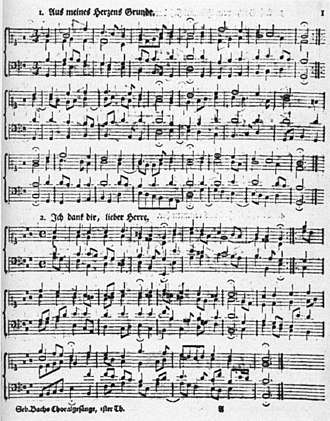Four-part harmony
The term "four-part harmony" refers to music written for four voices, or for some other musical medium—four musical instruments or a single keyboard instrument, for example—for which the various musical parts can give a different note for each chord of the music.
The four main voices are typically labelled as soprano (or treble),[2] alto (contralto or countertenor), tenor, and bass. Because the human voice has a limited range, different voice types are usually not able to sing pitches that lie outside of their specific range.[3]
The effort required to perform four-part harmony varies greatly. Pieces written in such a style can be usually executed by a single keyboard player, a group of 4 instruments (or singers), or even a large choir with multiple singers per part.
In European classical music

In the baroque era, a set of rules developed for voice leading in four-part harmony. In these rules, the bass voice would be assigned the root of the chord, although it can occasionally be assigned the fifth or the third. If the chord is a triad, the root is generally doubled by one of the other voices. When two voices are harmonized in perfect intervals (fourths, fifths and octaves), repeats of the same interval between the two voices (also known as moving in parallels) are almost always avoided.
Another rule concerns perfect cadences. In such cadences, the leading tone (the seventh scale degree) must resolve step-wise to the tonic. That is, the voice that plays the leading tone must resolve up to the tonic, and if the chord is a dominant seventh chord, the subdominant should resolve to the mediant.
Another concern of four-part writing is tessitura. Since the music is usually written for four-part choirs, each part should be able to be sung by the appropriate section of the choir, thus it should remain in the appropriate pitch range. As well as that, each voice should be easy to sing, meaning that large intervals within the same voice are to be avoided, instead favoring step-wise motion. Voices should also not overlap: the pitch sung by the alto should not be higher than that of the soprano, and so on for the other voices. Voices should also remain suitably close to each other, usually within an octave of each adjacent voice, except for the bass.
These rules were generally followed during the common practice period. Nowadays, they are usually taught in music theory classes, but most compositions follow less strict rules, if not outright disregarding them.[4][5][6]
Genres
- Barbershop quartets, originally from English-speaking North America, usually consist of four men or women who sing first tenor (called tenor), second tenor (called lead), baritone, and bass parts. A barbershop quartet typically emphasizes or exaggerates the harmonies in a piece of music, rather than singing in quiet supporting roles. The supporting voices can provide counter-melodies, close harmonies, or a walking bass to the melody line, which is sung in a middle voice. The harmonies are typically rooted in the chromatic aesthetics of early 20th-century popular music.
- Cantu a tenore is a Sardinian style, traditionally sung by men, wherein the second highest voice sings the melody, which the other voices accompany with a chant using nonsense syllables.
- The gospel quartet of the United States sings Christian material of a similar style to barbershop quartets, but may also include spirituals and traditional hymns.
- A Croatian klapa consists of four male parts, sometimes doubled, with the melody sung freely by a middle voice.
Four parts for instruments
Some music is written in four-part harmony for small groups of four instruments, such as a string quartet, a brass quartet, or a woodwind quartet. For instance, string quartets sometimes feature four part harmonizations, with the violins playing the top two parts, the viola playing the tenor part, and the cello playing the bass part. However, due to most musical instruments covering more pitches than a typical human voice, a quartet might play some harmonies with very high notes or very low notes, rather than using the limited range of choral music.
In larger orchestras or musical bands, some sections of instruments, such as violins, cellos, clarinets, flutes, trumpets, or French horns often have music written in four-part harmony. Similar to vocal music, the first part for a section of instruments typically plays the melody line, in some passages of a composition, with the other parts playing the supporting harmonies. The third part is often a harmonic mirror of the first part, which will sound somewhat melodic as well (if played separately). However, the second and fourth parts usually play close harmonies, in a more monotonous range, and rarely sound as melodic as the third part. Because musical instruments typically have a wider range than a human voice, any instrument in each section of a band or orchestra is usually able to play any of the four parts, although the first part often has higher notes or faster notes that only a more experienced musician can play well.
See also
References
- Benward & Saker (2003). Music: In Theory and Practice, Vol. I, p.159. Seventh Edition. ISBN 978-0-07-294262-0.
- McKinney, James (1994). The Diagnosis and Correction of Vocal Faults. Genovex Music Group. ISBN 978-1-56593-940-0.
- Boldrey, Richard (1994). Guide to Operatic Roles and Arias. Caldwell Publishing Company. ISBN 978-1-877761-64-5.
- "Basic Concepts of Four-Part Writing". Earlham College Music.
- Smey, Dave. "Important Rules for 4-Part Progressions" (PDF). Dave Smey. Retrieved 19 September 2016.
- Williams, Victoria. "The Rules of Harmony". www.mymusictheory.com. Retrieved 17 October 2017.
